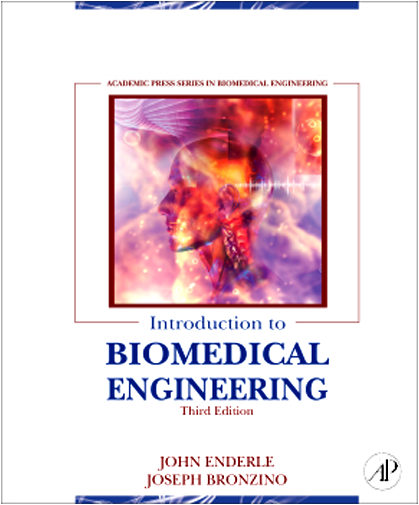
Introduction to Biomedical Engineering is an excellent undergraduate textbook that provides the reader with the foundations of biomedical engineering. This is an evolving field and the third edition is written to reflect some of the major advances.
The text is written for undergraduate engineering students who are familiar with differential equations and mechanics. However, it can also serve as a reference for researchers in biomedical optics who require an introduction to biomedical engineering principles and their applications in the development and use of biomedical devices and sensors. It is always useful to survey the fundamentals of a field before initiating a research project, and this textbook is a good starting point.
The authors infused the textbook with many worked examples that are based on MATLAB® and SIMULINK®, commercial computer programs available from The Mathworks, Inc. These computer programs are usually integrated into the curriculum of engineering students. The textbook contains an appendix that provides a concise introduction to these programs. I think that the use of these programs or equivalent programs such as Maple™ and MapleSim™, which are available from Maplesoft™, enhance the learning of biomedical engineering and prepare the students for their professional development.
I congratulate Joseph D. Bronzino for writing the first chapter, which provides the broad view of the field, its historical context, and the professional role of a biomedical engineer. Similarly, his second chapter on moral and ethical issues is of seminal importance. It frames the discussion on the moral, ethical, and legal foundations of human experimentation, informed consent, regulation of medical devices, and the ethical issues of the development and the federal regulation of medical devices, and the ethical consequences of biomedical engineering. These subjects are critical to both protect the people who are involved in clinical trials of a new medical device, and the long term surveillance of people that use the approved medical devices. A common mantra of people in the field of biomedical optics is: “from the bench to the bedside.” Therefore, it would be good practice for researchers in biomedical optics to also read these two initial chapters and to discuss and evaluate the potential consequences of their work. The exercises that accompany these two chapters are designed to provoke critical questioning and critical thinking. The suggested readings are useful, but unfortunately they are not current; many of them were written over a decade ago. I suggest the interested reader to consult a current and comprehensive book such as: The Oxford Textbook of Clinical Research Ethics, Ezekiel J. Emanuel et al. (Eds.), Oxford University Press (2011).
The field of biomedical engineering is vast, but the editors have selected a number of topics that provide the building blocks of the field. Considering the scope of the field this is a demanding task, but the editors have succeeded in organizing their textbook in a manner that is suitable for a course in biomedical engineering. Beginning with an overview of anatomy and physiology, the text proceeds to biomechanics and biomaterials, tissue engineering, compartment modeling, and biochemical reactions and their kinetics. These chapters provide a good introduction to the “bio” part of biomedical engineering. The mathematics and the physics are well integrated into these chapters. There are many solved problems throughout the textbook that provide the reader with helpful learning tools.
Biomedical engineering builds on the basics of mechanics, thermodynamics, electrical engineering, analog and digital signal processing, physiological modeling, medical imaging, biomedical optics, and the transport of heat, mass, and fluids. I found several of the chapters to be of strong pedagogical value due to their format and content. The chapter on bioelectric phenomena covers the history of the development of the Hodgkin-Huxley model of the action potential. The integration of electrical engineering, the voltage-clamp technique, the selection of the correct biological preparation (the giant squid axon), and the modeling of the phenomenon with a set of differential equations and their solution is a good object lesson for all students and researchers in biomedical engineering. Another exemplary chapter is on physiological modeling. Here again, the author provides a step-by-step approach to model a very interesting physiological system: saccadic eye movements. The author integrates the physics and the mathematics with clear diagrams and worked out problems. The use of SIMULINK® enhances the learning process.
Perusal of the entire text turned up some minor omissions and errors. The references should be updated to include modern and critical peer-reviewed publications and books. There is no substitute for reading the original publications in full. There are errors in the text; for example, the authors misspelled Planck’s constant, and wrote it as -bar, which is Planck’s constant divided by . They wrote the Boltzmann constant as , without stating that the standard form is . There are also errors in the index; e.g., Boltzmann constant is incorrectly cited on pp. 550–551. Planck is misspelled in the index. These errors should be listed in an erratum that is inserted in the textbook.
I recommend Introduction to Biomedical Engineering to the readers of the Journal of Biomedical Optics. It is eminently suitable as a textbook to accompany an undergraduate course.


